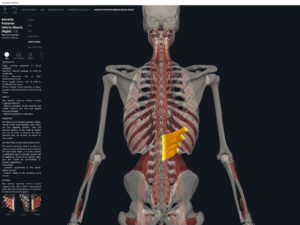Anatomy & Physiology: Muscles— Serratus Posterior Inferior.
Structure.
- Origin: spinous processes and supraspinous ligaments of T11-L2.
- Insertion: posterior aspect of ribs 9-12.
Function.
- Concentric action: depress ribs 9-12.
- Reverse mover action: contralateral rotation of T11-L2.
- Eccentric action: controls/restrains/slows elevation of ribs 9-12; ipsilateral rotation of T12-L2.
- Isometric action: stabilization of the lower ribs, and thoracolumbar spinal joints.
- Innervation: subcostal and intercostal nerves.
- Arterial supply: dorsal branches of posterior intercostal arteries.
Clinical Significance.
References
Biel, A. (2015). Trail guide to the body: A hands-on guide to locating muscles, bones and more.
Cedars-Sinai. (2018). Vertebrae of the spine. Retrieved from https://www.cedars-sinai.org/health-library/diseases-and-conditions/v/vertebrae-of-the-spine.html
Clark, M., Lucett, S., Sutton, B. G., & National Academy of Sports Medicine. (2014). NASM essentials of corrective exercise training. Burlington, MA: Jones & Bartlett Learning.
Jenkins, G., & Tortora, G. J. (2012). Anatomy and Physiology: From Science to Life, 3rd Edition International Stu. John Wiley & Sons.
Muscolino, J. E. (2017). The muscular system manual: The skeletal muscles of the human body.

